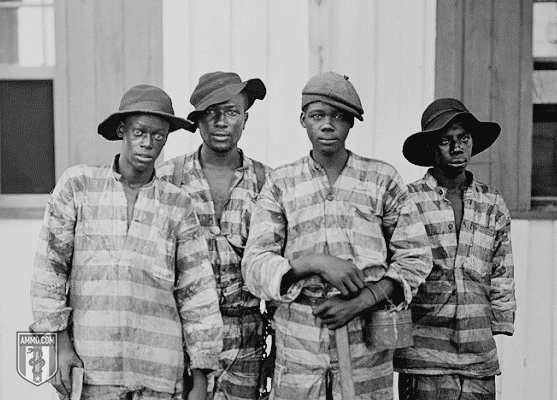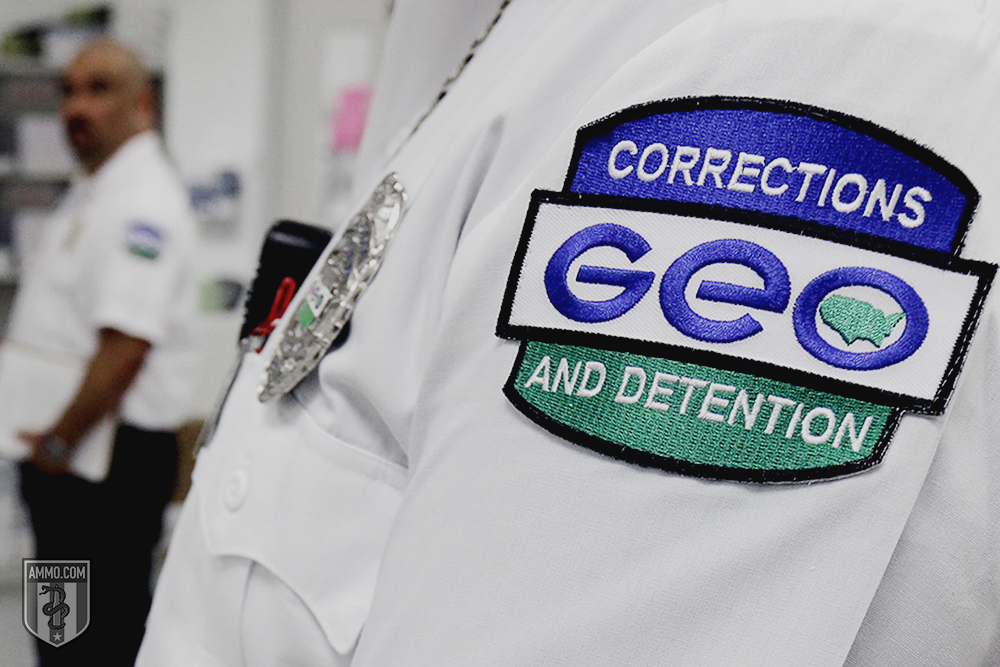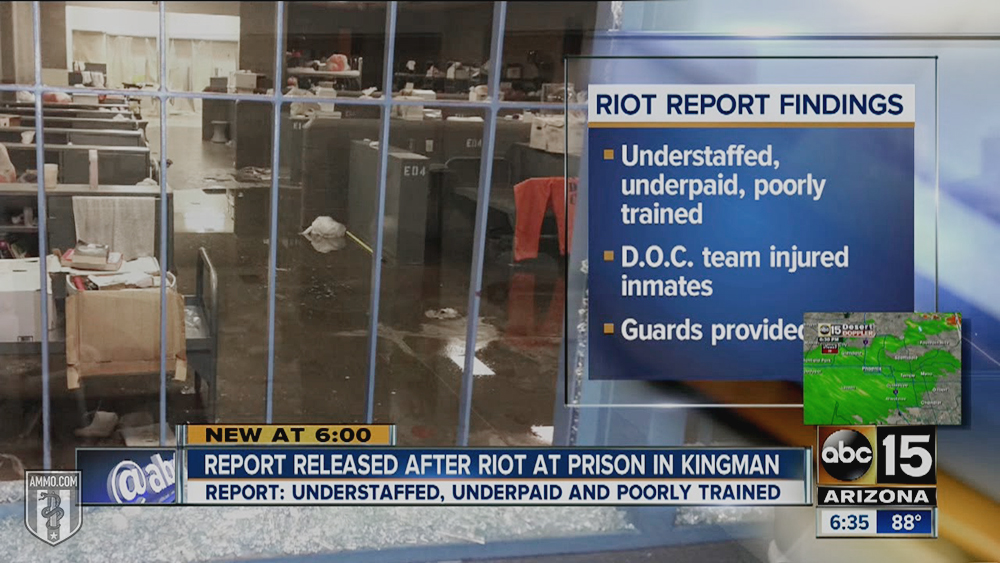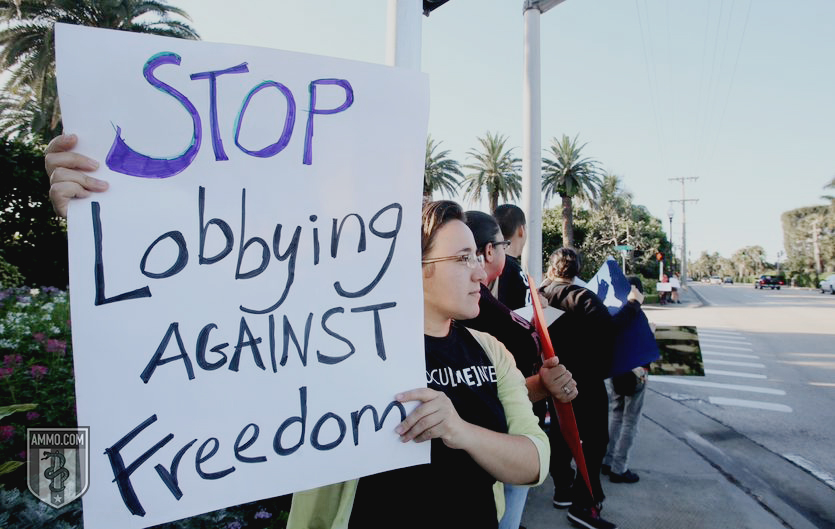Locked Up: How the Modern Prison-Industrial Complex Puts So Many Americans in Jail
You're free to republish or share any of our articles (either in part or in full), which are licensed under a Creative Commons Attribution 4.0 International License. Our only requirement is that you give Ammo.com appropriate credit by linking to the original article. Spread the word; knowledge is power!
Where you find the laws most numerous, there you will find also the greatest injustice.
There’s no two ways about it: The United States of America and its 50 state governments love putting people in prison.
The U.S. has both the highest number of prisoners and the highest per capita incarceration rate in the modern world at 655 adults per 100,000. (It’s worth noting that China’s incarceration statistics are dubious, and they execute far more people than the United States. Indeed, the so-called People’s Republic executes more people annually than the rest of the world combined.) Still, that’s more than 2.2 million Americans in state and federal prisons as well as county jails.
On top of those currently serving time, 4.7 million Americans were on parole in 2016, or about one in 56. These numbers do not include people on probation, which raises the number to one in 35. Nor does it include all of the Americans who have been arrested at one time or another, which is over 70 million – more than the population of France.
For firearm owners in particular, the growth in this “prison-industrial complex” is troubling because felons are forbidden from owning firearms and ammunition under the 1968 Gun Control Act. As the number of laws has grown and the cultural shift for police has gone from a focus on keeping the peace to enforcing the law, more and more Americans are being stripped of their 2nd Amendment rights (not to mention other civil rights like voting – as of 2017, 6.1 million Americans cannot vote because of their criminal records). All told, eight percent of all Americans cannot own firearms because of a felony conviction.
For American society as a whole, the prison-industrial complex has created a perverse incentive structure. Bad laws drive out respect for good laws because there are just so many laws (not to mention rules, regulations, and other prohibitions used by federal prosecutors to pin crimes on just about anyone). How did we get here?
History of Incarceration in the U.S.
 United States law is, of course, based on English common law. Thus, no history of incarceration in the United States can start without first discussing the history of incarceration in the Kingdom of England and later the United Kingdom of Great Britain.
United States law is, of course, based on English common law. Thus, no history of incarceration in the United States can start without first discussing the history of incarceration in the Kingdom of England and later the United Kingdom of Great Britain.
The prevailing notion of where crime came from in the old country and the colonies was idleness. Punishments often involved sending criminals to workhouses, which were quite distinct from the prisons we know today. Rehabilitation and reform weren’t strong currents in the English and later British penal system until the 1700s. Reformers sought to improve the criminal and to make him not want to offend.
Another historical fact worth noting is that incarceration is a relatively recent innovation in punishment. Historically, criminals were punished by shaming, corporal punishment, mutilation, exile and death. The purpose was generally not to make the criminal better, but to deter him from offending again while simultaneously providing the community with some awareness of his crimes for the purpose of allowing them to take measures to protect themselves (for example, branding a “B” on the forehead of a burglar). Where criminals were incarcerated, it was generally a temporary measure prior to trial or post-trial punishment, not a punishment in and of itself.
Remember, a significant portion of early American settlers were convict laborers. This convict labor was not incarcerated, but rather freely mingled with the general population. For the safety of the non-criminal elements, they had to be quickly and easily identified. However, the early American colonies were in no position to expend resources to house, feed and clothe criminals who were not providing productive labor – which is why incarceration made about as much sense as cutting off a criminal’s hand. Only four types of criminals were prohibited from being shipped across the ocean from England: murderers, rapists, burglars, and witches.
Prison became the primary means of punishment for felonies in the years leading up to the American Revolution. Two systems emerged: One where prisoners were incarcerated alone and another where they were incarcerated in groups. For what it’s worth, most prisons were in the North. Throughout the South, crime was largely viewed as a northern problem. Rather than prison, the Antebellum South relied heavily on extra-judicial violence and honor culture to keep their crime rates low.
Prison labor has been a feature of prisons going back to days of English and British colonial rule. However, the convict lease system changed this qualitatively in the late 1880s. This is when prisons began to be paid for the labor of their convicts. Many times, convicts were put to work on plantations. Building railroads and coal mining were other common uses of convict labor during this period. Death rates were high. In Alabama, a full 40 percent of convicts used for leased labor died in 1870.
The convict lease system gradually died out. However, it was replaced with systems not terribly distinct from convict labor. The chain gangs and prison farms closely identified with southern punishment throughout the 20th Century are examples of what began to replace the convict lease system. While there were rumblings about bringing back the chain gang system in the 1990s, it never amounted to much.
Overcriminalization = Less Civil Liberties
 One of the fundamental principles underpinning our Constitutional republic is that the citizenry should not accept “trust me” as an answer from the federal government. Yet in one of our most Orwellian of federal departments – the Department of Homeland Security – a surveillance state is growing as our private information “trusted” to the government is used against us.
One of the fundamental principles underpinning our Constitutional republic is that the citizenry should not accept “trust me” as an answer from the federal government. Yet in one of our most Orwellian of federal departments – the Department of Homeland Security – a surveillance state is growing as our private information “trusted” to the government is used against us.
This surveillance state is made possible by Fusion Centers, police intelligence agencies that allow different police agencies to share intelligence with one another. It is, in effect, the intelligence-gathering method of the burgeoning police state. And the information gathered, received, analyzed and disseminated by local and state police agencies is then shared with the federal government.
Fusion Centers aren't the only way police surveil citizens. Cell-site simulator devices – known as Stingrays – mimic wireless carrier cell towers to connect to nearby mobile phones and cell data devices. These controversial devices can extract data, intercept communications, conduct denial-of-serice attacks, find encryption keys, and more. It's a serious threat to Americans' privacy and civil liberties, first conceived during the War on Terror and now trickled down to local police departments and their militarized approach to enforcing the law.
Of course, while we’re assured that protections are being made for privacy and civil liberties, there is very little reason to trust the federal government – including the growing number of vague laws.
It’s easy to blame the War on Some Drugs as the reason for the explosion in the prison population, however this is simply not an adequate explanation. The real reason is a broad expansion in the total number of laws on the book and the vague manner in which they are written. What’s more, the concept of intent has largely disappeared from our national legal lexicon, meaning that simple mistakes are often enough to land a person in prison.
66-year-old George Norris provides a case study. He was greeted by three pickup trucks filled with six officers outfitted in flak jackets. He was held for four hours while the police searched his house, eventually seizing 37 boxes of his things with neither warrant nor explanation. He was indicted for orchid smuggling under the Convention on International Trade in Endangered Species and for (what else) making false statements to an officer for a simple paperwork error. While being held for trial, he shared a cell with an accused murderer. He was facing five years for the original charge and five years for conspiracy. Because he couldn’t afford his legal bills, he plead guilty and was sentenced to 17 months in prison.
Another broad example is civil-contempt imprisonment. This is where people are put in jail or prison for failure to, for example, respond to a bench warrant for an unpaid parking ticket. This is what Anthony W. Florence was arrested for while riding as a passenger in his family’s car with proof that he had paid the tickets. He spent seven days in jail where he was strip searched twice. Guards also watched him shower and subjected him to a delousing. People have also been imprisoned for failing to pay debts in accordance with court-ordered settlements, which carries the specter of the return of debtors’ prisons with it.
The Principle of Minimum Necessary Force
Minimum necessary force is a concept dating back to Plato, but has recently found expression in Dr. Jordan Peterson’s book 12 Rules for Life. Basically, the idea is that when someone wrongs another person, the correct course of action is always the one requiring the least force. This is why, for example, we can say that the Islamic practice of removing a thief’s hand is somehow objectively unethical – it is a punishment grossly out of proportion to the crime committed.
The secondary aspect to the principle of minimum necessary force is the notion that the best way to go about laws is to have as few as are necessary. While not strictly speaking “libertarian,” it’s sort of “libertarian adjacent.” Laws are, ultimately, a type of force. The more of them we have, the more force we have in society.
The present state of criminal justice in the United States violates both principles. Not only do we have far more laws than we need (criminal asset forfeiture, for example), but the punishments are frequently far out of sync with the crime committed. Is prison time really an appropriate response to someone smuggling orchids into the United States?
The Violent Crime Control and Law Enforcement Act of 1994
During his 1992 presidential campaign, then-candidate Bill Clinton was frequently attacked by his opponents as being “soft on crime.” He later won the endorsement of the 135,000-strong National Association of Police Officers by promising to put 100,000 new police officers on the streets. The result of Clinton’s desire to get tough on crime was the Violent Crime Control and Law Enforcement Act of 1994, written by Joe Biden – though he actually gave credit to the National Association of Police Officers, saying: “You guys sat at that conference table of mine for a six-month period, and you wrote the bill.”
The 1994 crime act was a sweeping reform of police powers in the United States. It included provisions regarding immigration, so-called “hate crimes,” street gangs and séx offender registries.
Perhaps most of interest to our readers is the Federal Assault Weapons Ban of 1994. This was Title XI of the Violent Crime Control and Law Enforcement Act of 1994. This provision banned a number of semi-automatic weapons, both rifles and pistols. Studies have shown that this law did not have a significant effect on homicides committed with firearms. The Gun Debate: What Everyone Needs to Know by Philip J. Cook and Kristin A. Goss found that "There is no compelling evidence that [the ban] saved lives."
The assault weapons ban was subject to a sunset provision and expired on September 13, 2004. There have been repeated attempts in Congress to pass a new assault weapons ban, but all have been unsuccessful.
This was not the only provision of the Act. Title VI, known as the Federal Death Penalty Act, created 60 new capital offenses including narcotics trafficking and civil rights-related homicides.
Title IV was the Violence Against Women Act. This innocuous sounding act made it more difficult for those accused of violence against women to defend themselves in court, which, also funneling more federal money to battered women’s shelters, created the National Domestic Violence Hotline and increased the power of restraining orders.
Likewise, the law stripped inmates of their eligibility for Pell Grants, increased privacy for driver’s license holders in public records databases, increased tracking of séx offenders, authorized the hiring of 100,000 additional police officers, expanded mandatory minimum sentencing, and created “boot camp”-style prisons for minors. Gang membership itself was criminalized. Drug testing was made mandatory for anyone on federal supervised release. “Three strikes” was made federal law as well.
The main impact of the law was a massive explosion in the number of incarcerated Americans. While crime declined sharply during the 1990s – 26 percent – not everyone agrees that the bill and the increased incarceration rate is due the credit. Some argue that all the bill did was incentivize incarceration by providing state and local governments with material benefits for increasing their incarceration rates. There were approximately one million Americans incarcerated in 1990. By 2000, that number had ballooned to approximately 1.5 million, peaking at nearly 2.5 million just before 2010.
For what it’s worth, the argument that most of these people are in jail for non-violent drug offenses is simply untrue. In 2016, 200,000 (less than 16 percent of all state inmates) were doing time for drug offenses. Compare this to the 700,000 incarcerated for violent crimes at the state level. In 2020, the Bureau of Prisons, which oversees federal inmates, tells a different story: 70,681 or 45.9 percent of federal inmates are doing time for drug charges, more than any other class of inmate. The lion’s share of inmates, however, are serving time in state rather than federal prisons.
The legacy of the Violent Crime Control and Law Enforcement Act of 1994 is a controversial one. It’s unclear whether or not it is responsible for the reduction of crime, but it’s crystal clear that it is responsible for a spike in the nation’s incarceration rate. Whatever one’s conclusion is on the matter, there is a certain irony to President Donald Trump running against the Act that Biden wrote – and Biden drawing a significant amount of support from people who want to abolish the police.
The Rise of Private Prisons
 You cannot have a discussion on the prison-industrial complex without discussing private prisons. As of 2018, private prisons housed 8.41 percent of incarcerated persons in the United States. While private prisons date back to the colonial days, the modern privatized prisons as we think of them only date back to the 1980s. This was initially due to the explosion of prison population and resulting prison overcrowding that some have tied to the War on Some Drugs.
You cannot have a discussion on the prison-industrial complex without discussing private prisons. As of 2018, private prisons housed 8.41 percent of incarcerated persons in the United States. While private prisons date back to the colonial days, the modern privatized prisons as we think of them only date back to the 1980s. This was initially due to the explosion of prison population and resulting prison overcrowding that some have tied to the War on Some Drugs.
This spike in incarceration, however, is far more closely tied with the rise of private prisons. Between the years 1925 and 1980, the prison population in the United States remained constant as a proportion of the overall population. In 1983, however, two things happened: First, the first private prisons came into operation. Second, the prison population as a proportion of the overall population began to explode.
The first modern private incarceration company was Corrections Corporation of America (CCA), founded in 1983, and is currently known as CoreCivic. Their first contract was for a facility in Shelby County, Tennessee. This was the first time in American history when a government-run jail was contracted out to a private third party. The company made quick headlines when it offered to take over the entire prison system for the state for the sum of $200 million. The state, for its part, was quite ready to make a deal, but the backlash among the public, the prison guards union, and the state legislature ultimately squashed the deal.
This was hardly the end of the for-profit prison system. Fully 19 percent of all federal inmates are housed in privately owned and operated prisons. A comparatively lower 6.8 percent of all state inmates are housed in private prisons.
Since its founding, CoreCivic has seen a 200-percent increase in its profits. So it’s no surprise that the marketplace for private prison companies has become a bit crowded. Companies like the GEO Group, Inc. (formerly known as Wackenhut Securities), Management and Training Corporation (MTC), and Community Education Centers compete in a marketplace that took in $500 billion in 2011 alone according to Matt Taibbi’s book The Divide: American Injustice in the Age of the Wealth Gap.
The book further points out that major Wall Street money has flowed into this industry. Wells Fargo alone has $100 million invested in GEO Group and another $6 million in CCA. Fidelity Investments, The Vanguard Group, General Electric and Bank of America are likewise heavily invested in private prisons.
Some other numbers give a bit of shape to the scale of private prisons: CoreCivic has 80,000 beds in 65 different facilities. The GEO Group has 49,000 beds spread out over 57 correctional facilities. Most private facilities are in the West and the Southwest, where state and federal prisons freely mingle with one another.
Private Prisons Are Not Safe
 Private prisons are, by virtually every metric, a worse place to hang your hat than government prisons. A United States Department of Justice report in 2016 found that private prisons were less secure, less safe, and more punitive than government-run prisons. The DOJ stated that it would cease the use of private prisons. However, soon thereafter, the Department of Homeland Security announced that it would renew its contract with CCA operation of the South Texas Family Residential Center, an immigration detention facility. Stock prices for private incarceration firms spiked upon the election of Donald Trump. President Trump’s Attorney General Jeff Sessions overturned the previous ban on private prisons.
Private prisons are, by virtually every metric, a worse place to hang your hat than government prisons. A United States Department of Justice report in 2016 found that private prisons were less secure, less safe, and more punitive than government-run prisons. The DOJ stated that it would cease the use of private prisons. However, soon thereafter, the Department of Homeland Security announced that it would renew its contract with CCA operation of the South Texas Family Residential Center, an immigration detention facility. Stock prices for private incarceration firms spiked upon the election of Donald Trump. President Trump’s Attorney General Jeff Sessions overturned the previous ban on private prisons.
The lax culture of safety and security in private prisons is not just a problem for the inmates. It’s also a problem for the people in the communities where the prisons are located. For example, three murderers escaped from a minimum/medium security prison – Kingman Arizona State Prison – in Mojave, Arizona. This resulted in a murder, robbery and carjacking before the men were captured. The state Attorney General, Terry Goddard, laid the blame at the feet of the private prison system, which he said was not adequate for the task of incarcerating these kinds of hardened criminals.
The state did an extensive report on this prison after the jailbreak, which found a number of problems with the privately-run prison:
- The prison’s alarm system sent off so many false alarms that prison guards simply began ignoring them.
- Eight of the floodlights used on the prison yard were burnt out.
- Prison guards weren’t properly armed, nor were they properly trained with firearms.
- 75 percent of all inmates in the facility did not have the appropriate identification.
While it’s certainly true that government-run prisons are far from perfect, and often have budgetary issues, it’s hard to ignore the potential corner-cutting that may have led to this escape and the subsequent deaths.
Then, of course, there was the “kids for cash” scandal. The short version of the story is that two judges in Pennsylvania were receiving kickbacks for sending children to private prison facilities. Millions of dollars were processed to the two judges for giving out prison time for such offenses as mocking an assistant principal on MySpace and trespassing in an abandoned building. The two judges were sentenced to a combined 45.5 years in prison. Every juvenile offender who appeared before the judges had their convictions overturned, and a class action lawsuit is currently pending.
Unsurprisingly, cost-benefit analysis of private prisons tend to have a “both sides” feel about them. Studies funded by the industry frequently tout the cost benefits of private operation. Studies funded by state-funded institutions, such as universities, tend to paint private prisons as bloated and inefficient.
Prison Guard Unions and Private Prisons Lobbying Elected Officials
 Anywhere government money is being spent or the state is picking winners and losers, there you will find lobbying. Like the military-industrial complex, private prisons are no exception to this rule. The two largest private prison corporations have put more than $10 million into electing favorable candidates since 1989, and more than $25 million into lobbying.
Anywhere government money is being spent or the state is picking winners and losers, there you will find lobbying. Like the military-industrial complex, private prisons are no exception to this rule. The two largest private prison corporations have put more than $10 million into electing favorable candidates since 1989, and more than $25 million into lobbying.
Marco Rubio is an excellent example of the power of the private prison lobby. He has very close ties to the GEO Group, the second-largest for-profit prison company in the United States. GEO was the recipient of a state contract for a $110 million prison during Rubio’s tenure as the Speaker of the House in Florida. This right after Rubio hired an economic consultant with close ties to the company, which has donated nearly $40,000 to his various political campaigns as of 2015. This makes him the politician with the closest financial relationship to the private prisons industry.
The private incarceration industry has stepped up their lobbying game during the Trump Administration, with the GEO Group spending $1.3 million on lobbying between January and September 2017. That topped the total from the previous year, which was $1 million.
The timing of the increase in lobbying funds is worth considering. Immigration and Customs Enforcement (ICE) was looking to build five new detention centers at the time. Unsurprisingly, companies started lobbying hard to be the ones to build and operate these new facilities. That’s over 54,000 beds. What’s more, ICE is the number-one customer for the GEO Group, which is based in Florida.
Rubio is hardly the only politician to receive funding from private prison companies – which claim to never attempt to influence policy in any way other than trying to get contracts for private prison operation. Chuck Schumer has received over $100,000 in donations from both the GEO Group and CCA.
While private prison operations companies claim they do not attempt to influence public policy beyond trying to get those lucrative contracts, the same cannot be said for prison guard unions. The California prison guards union spent $100,000 in 1994 trying to get the three strikes law passed. This was the first of its kind, but quickly became the gold standard across the nation. 28 states have such laws as of 2018. The same union spent over $1 million to defeat Prop 5, which, if passed, would have reduced sentences for nonviolent crimes and created more drug addiction treatment resources in the state. Another $1 million was spent to defeat Prop 66, a measure designed to reduce the number of crimes carrying mandatory life sentences.
Modern Prison Labor
 Because compulsory, unpaid prison labor is not prohibited by the United States Constitution, some have argued that prison labor is a continuation of chattel slavery.
Because compulsory, unpaid prison labor is not prohibited by the United States Constitution, some have argued that prison labor is a continuation of chattel slavery.
However, prisoners are not owned by the state. What’s more, they are generally paid – albeit between $0.12 and $0.40 per hour. Prisoners, when taken as a whole, represent the third largest labor pool in the world. And while they engage in all kinds of labor, it tends to be manually intensive, low-skilled, deeply unpleasant and highly profitable for the corporations who are able to take advantage of it.
The days of prisoners making license plates and breaking rocks are long gone. Employers now receive a substantial tax credit ($2,400) for work-release labor. There’s even a euphemism for private companies who take advantage of prison labor – “Prison insourcing” – and it’s becoming increasingly popular with large firms. The list of organizations with significant prison labor include popular brands like Whole Foods, Target, Starbucks, Victoria's Secret, McDonald's, IBM, Honda, Texas Instruments, Boeing, Nordstrom, Intel, Aramark, AT&T, BP, Microsoft, Nike, Macy's, Wal-Mart and Sprint.
Prison labor is not without its benefits for the prisoners or for society at large. It can be a valuable outlet for prisoners, keeping them from getting into trouble and teaching them new skills. What’s more, many inmates have never had a legal job before. This means they have to learn the most basic aspects of holding down a job – like showing up on time, working with others as a team, and listening to instructions from a supervisor. Many studies show that prison employment leads to reduced recidivism rates.
While companies profit from prison labor, they’re also cleaning up in other ways. JPay, which began as a way to wire money to people on the inside, has seen rapid success with a monopoly on how prisoners’ friends and family can communicate with them inside some state prison systems. All told, JPay had contracts with 21 state correctional facility systems and a number of private facilities as of August 2018. With no paper mail allowed, JPay charges per electronic message – making the company millions, and making prisoners the ultimate captive audience.
The First Step Act: President Trump’s Prison Reform Bill
Few would have expected a Republican president to spearhead prison reform. Then again, President Trump isn’t just any Republican.
Overwhelmingly passed by the Senate – 87 to 12 – in December 2018, the First Step Act is the Trump Administration’s bipartisan victory to save money by reducing prison sentences. While some Republicans feared this vote would reflect as being soft on crime, Senate Judiciary Committee Chairman Sen. Charles E. Grassley stressed that Trump “wants to be tough on crime, but fair on crime.” Shortly after the vote, Trump tweeted that his “job is to fight for ALL citizens, even those who have made mistakes” and that this bill will “provide hope and a second chance, to those who earn it.”
The reform in this criminal justice bill is pretty significant. It reduces mandatory sentences, cutting a collective 53,000 years off existing sentences over the next 10 years. It creates sentencing disparity between powder and crack cocaine, and reduces recidivism rates. And it decreases the “three strikes” penalty for drug felonies from life to 25 years.
But not everyone thinks this reform bill is a "first step" in the right direction. Since it doesn’t apply to local jails or state prisons, those skeptical of this new legislation have pointed out that it only affects about 10 percent of the country’s incarcerated population – hardly a dent. Many also disagree with the fact that this bill will release high-risk inmates and offenders.
Libertarian magazine Reason is in favor of more reform. A 2016 article asked the question “Should Felons Get Their Gun Rights Back?” The argument is roughly the same as that of restoring voting rights to felons: Once people have served their time and been released, society assumes that the ledger has been balanced. If someone cannot be trusted to own firearms once they have been released from prison (presumably because they are dangerous), why are they out on the street and not in a cell?
For those interested in Second Amendment freedom, all of this is important. In a sense, the gun grabbers are getting through our prison-industrial complex what they cannot get through either the legislature or the courts – a disarmed populace.
Civil Liberties
- Right to Know: A Historical Guide to the Freedom of Information Act (FOIA)
- The TSA and Security Theater: Understanding American Airport Security Following 9/11
- Asymmetrical Warfare and 4GW: How Militia Groups are America's Domestic Viet Cong
- Weapons of War On Our Streets: A Guide to the Militarization of America's Police
- Policing For Profit: How Civil Asset Forfeiture Has Perverted American Law Enforcement
- Locked Up: How the Modern Prison-Industrial Complex Puts So Many Americans in Jail
- The 16th Amendment: How the U.S. Federal Income Tax Became D.C.'s Favorite Political Weapon
- America's Sovereign States: The Obscure History of How 10 Independent States Joined the U.S.
- Freedom vs. Liberty: How Subtle Differences Between These Two Big Ideas Changed Our World
- Bowling Alone: How Washington Has Helped Destroy American Civil Society and Family Life
- The 9/11 Attacks: Understanding Al-Qaeda and the Domestic Fall-Out from America's Secret War
- Food is Freedom: How Washington’s Food Subsidies Have Helped Make Americans Fat and Sick
- Black America Before LBJ: How the Welfare State Inadvertently Helped Ruin Black Communities
- Deep State Mayor Pete: Could Former Naval Intelligence Officer Pete Buttigieg Be a CIA Asset?
- Bubble-Wrapped Americans: How the U.S. Became Obsessed with Physical and Emotional Safety
- Democrats & Jim Crow: A Century of Racist History the Democratic Party Prefers You'd Forget
- Constitutional Republic vs. Pure Democracy: How the U.S. Election Process Has Changed
- Natural Born Citizens: Understanding Who Can Be POTUS in a Nation Beset By Divided Loyalties
- War on the Suburbs: How HUD's Housing Policies Became a Weapon for Social Change
- Woke Capitalism: How Huge Corporations Demonstrate Status by Endorsing Political Radicalism
- Cultural Marxism's Origins: How the Disciples of an Obscure Italian Linguist Subverted America
- Godfather of Color Revolutions: Is George Soros the Most Dangerous Man Alive?
- The Great Reset: The Global Elite's Plan to Radically Remake Our Economic and Social Lives
- Righteousness + Force in America: The Trap of Righteous Activism Coupled with State Power
- A Distributed Capacity for Violence: A Brief History of Weapons Technology and Political Power
